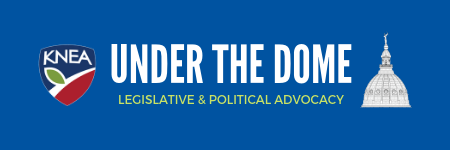UPDATE 8:30 p.m.:
As the evening draws to a close, the House Substitute Bill to fix funding equity has been passed by a vote of 116-6 with the Senate following shortly thereafter with only one no vote from Senator Mary Pilcher-Cook. With the passing of this legislation, it appears that a fix which will pass Constitutional muster has been achieved and schools will open as so many in the education community have demanded for many months.
KNEA President Mark Farr, suggested that tonight’s effort resulting in a bipartisan solution offered a clear path forward to correct the cycle of crisis Governor Brownback’s policies have created. “First and foremost, I’m encouraged that common sense has finally found a place in this Legislature and that schools will be open this fall. My hope is that this won’t be a fleeting election year moment, but instead a moment where our leaders realize what collaboration and compromise can accomplish for Kansas students.”
While many of the Governor’s closest allies in the Legislature took to social media to congratulate themselves on a job well done, others pointed out that the solution came only after the urging of parents, students, educators, and citizens. One parent in attendance was quoted as saying, “they should take care not to injure their arms patting themselves on the back for doing their job to fix a problem they created. I won’t forget at the ballot box what and who was responsible for this mess to begin with.”
KNEA President Farr summarized the events aptly saying, “now we move directly into an election cycle where we have real choices to make. Now we can begin the long journey of truly ending the Brownback experiment and replacing those in the Legislature who have stood by his policy to the detriment of our state and our students.”
As it became clear early today that there were not enough votes in the House to pass out the version of the equity funding fix in HB 2001, there appears to be an effort to craft a new bill. The sticking point in HB 2001 is that it seeks to solve equity by cutting funding from all districts by 0.5%. Many believe the bill will not pass constitutional muster because of this. Support for additional cuts exists only within the most conservative block of representatives. For many months, these same law makers have been touting the need to ensure that more dollars make it into the classroom. Yet HB 2001 takes money from school district operating budgets – from the classroom.
The new proposal seeks to address the $38 million dollars needed to fulfill the equity ruling by using funds from other sources to avoid cuts to districts. Specifically, the latest version of the new bill would see the sale of the Kansas Bioscience Authority backfill the funding deficit up to $13 million. Additional sources of revenue would come from the Extraordinary Needs Fund and TANF (Temporary Assistance to Needy Families). View a scan of the full handout distributed in the appropriations committee hearing by clicking here.
Education supporters from throughout the state including Kansas NEA have been unwavering in their call to the Legislature to solve the equity issue to the satisfaction of the Courts and ensure schools open this fall. Focusing on that effort should be the singular focus of the Legislature. Today’s activity under the dome may indicate representatives are moving towards a compromise. Still, this situation is very fluid and as we’ve seen in the very recent past, anything is possible.
What happens next?
After the new bill is introduced into the House it is expected that Legislators will return to their home districts for the weekend and resume work on the bill on Monday. KNEA will continue to maintain a presence in the statehouse and report on activity through Under the Dome. Take any opportunity you have to reach out and contact your representatives. Tell them that their singular focus should be to pass a clean funding bill which fulfills the Supreme Court’s ruling on equity.
What about the Senate?
The Kansas Senate has its own nearly identical version of HB 2001 titled SB 1. While many in the Senate pushed for Senators to focus on that bill as it is their Constitutional duty to do, Senator Jeff King instead introduced a Senate Resolution. The Resolution would allow a statewide vote on a Constitutional amendment stripping the Courts of the power to “threaten to close our schools” as Senator King reiterated.
Senator Anthony Hensley characterized King’s resolution as a “red herring,” intended to distract the body from the purpose of the special session which is to resolve the equity issue. It was pointed out in discussion that existing law prohibits the Courts from threatening to close schools, but the deeply conservative faction in the Senate pressed forward. Senators Holmes, Abrams, Arpke, and Masterson engaged in varying degrees of rhetoric criticizing the Courts as “all powerful” and “extremists.”
The proposed amendment failed to get the required 2/3 vote necessary to pass the Senate.
How did we get here?
The Supreme Court has simply followed its lawful procedure in this case. After taking the case brought before the Court upon complaint of citizens, the Court ruled that an unconstitutional and unlawful funding condition exists relative to Kansas public schools. One part of that condition is equity. The Courts ruled that the Legislature would have until June 30, 2016 to resolve this unconstitutional condition or the Courts would be forced to suspend the distribution of funds to an unconstitutional system. Closing schools is one possible outcome caused by the failure to address the unconstitutional aspects of the formula.


